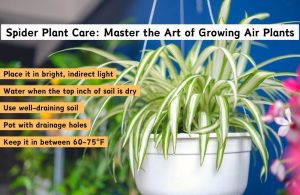This article covers the following areas –
- Lighting Requirements
- Watering Requirements
- Fertilizer/Nutrition Requirements
- Temperature and Humidity Requirements
- Pruning Arrowhead Plants
- Repotting Arrowhead Plants
- Pest Control for Arrowhead Plants
- Keep Pets and Children in Mind
- Final Thoughts
- Frequently Asked Questions
- Get to Know Your Arrowhead Plant
Arrowhead plants are considered low-maintenance and beginner-friendly houseplants. They can adapt to a variety of light conditions and require only moderate watering. However, if you are a beginner, I’ll share some essential care tips to keep your plant happy and healthy.
Keep arrowhead plants in bright, indirect light and water when the top inch of soil is dry. Use half-strength liquid fertilizer every 4-6 weeks during the growing season, and prune long or yellowing leaves. Maintain a temperature of 60-85°F (15-29°C) and provide extra humidity if needed.
Now, let me share some tips for caring for your arrowhead plant. By following these tips, you can ensure the best growth and health of your indoor beauty.
Lighting Requirements

Arrowhead plants (Syngonium podophyllum) thrive in various light conditions, ranging from low to bright indirect light. However, they prefer bright, indirect light to promote vibrant foliage colors and steady growth. Avoid direct sunlight, which can scorch their beautiful leaves.
Arrowhead plants are highly versatile regarding lighting, making them excellent indoor plants. While they can tolerate low light, their ideal condition is bright, indirect light. Placing them near a window with filtered sunlight helps them flourish.
Bright, indirect light allows your arrowhead plant to reveal its vibrant foliage colors and grow robustly. The plant will showcase its true potential in such conditions, maintaining its beautiful hues and growing steadily.
If the leaves appear dull or lose their color, it may indicate that your arrowhead plant needs more light. Moving it to a brighter spot can help revive its natural beauty. However, it must still be protected from direct sunlight, which can scorch the leaves.
Arrowhead plants adapt well to lighting changes but need some time to adjust. Gradually move the plant closer to the light source to avoid stress or sunburn. If placed in low-light conditions, expect slower growth but not significant leaf loss.
Practical Tips for Optimal Light
- Place your plant near an east-facing window for morning sun or a north-facing window for consistent indirect light.
- Rotate the plant occasionally to ensure all sides receive equal light exposure.
- Use sheer curtains or blinds to filter harsh sunlight, preventing leaf scorching.
By providing the perfect balance of light, your arrowhead plant will thrive and become a stunning addition to your indoor space. Keeping it in bright, indirect light will maintain its vibrant colors and steady growth, bringing life and beauty to your home.
Watering Requirements

Arrowhead plants thrive in evenly moist soil but dislike waterlogged conditions. Water them when the top inch of soil feels dry to the touch, ensuring the soil drains well. Use a pot with drainage holes and a well-draining soil mix to prevent root rot.
A well-draining pot is essential for keeping your arrowhead plant healthy. Pots with drainage holes at the bottom allow excess water to escape, preventing roots from sitting in soggy soil. This drainage setup reduces the risk of waterlogging and root rot.
A well-draining soil mix is just as crucial as the pot. Arrowhead plants benefit from a mix that includes perlite, vermiculite, or coarse sand. This combination retains the right amount of moisture while ensuring excess water can drain away quickly.
Moderate Watering Practices
- Water the plant when the top inch of soil feels dry.
- Check the soil’s moisture level regularly to prevent overwatering.
- Ensure the pot and soil mix allow for proper drainage to avoid root damage.
Overwatering can lead to yellowing leaves, a musty smell from the soil, and root rot. These symptoms indicate that your plant may be sitting in overly wet soil, which promotes fungal growth and can severely damage or kill your arrowhead plant.
To avoid overwatering:
- Wait until the top inch of soil is dry before watering.
- Check for adequate drainage in both the pot and soil mix.
- Water thoroughly but infrequently, ensuring excess water drains out.
By striking the right balance with watering, providing proper drainage, and using a suitable soil mix, you can maintain the health and vibrancy of your arrowhead plant. Moderation in watering and careful attention to soil conditions will ensure your plant thrives without the risk of root rot or other water-related issues.
Fertilizer/Nutrition Requirements

Arrowhead plants are easygoing regarding fertilizer but enjoy a nutrient boost occasionally. Feed them with a half-strength, water-soluble fertilizer every 4-6 weeks to encourage strong growth in spring and summer.
The plant’s growth slows down in the fall and winter, so reduce feeding frequency or skip it altogether. Excess fertilizer can harm the plant, so always follow the label instructions carefully to avoid overfeeding.
Choosing the Right Fertilizer
- Opt for a balanced, water-soluble fertilizer (like 10-10-10 or 20-20-20).
- Dilute the fertilizer to half-strength to prevent nutrient overload.
- Apply the solution directly to moist soil after watering to reduce the risk of root burn.
Over-fertilizing can lead to leaf burn, yellowing, or stunted growth. If these symptoms appear, flush the soil with plenty of water to remove excess fertilizer salts and skip feeding for a while.
Fertilizing Tips for Healthy Growth
- Feed every 4-6 weeks during the growing season (spring and summer).
- Skip fertilizing during dormant periods in fall and winter.
- Ensure the soil is moist before applying fertilizer to prevent root damage.
By providing a balanced fertilizer in moderation, your arrowhead plant will receive the nutrients it needs to thrive without the risk of over-fertilization. Follow a regular feeding schedule during the growing season and ease off in the dormant months to keep your plant vibrant and healthy.
Temperature and Humidity Requirements

Arrowhead plants thrive in standard indoor temperatures ranging from 60-85°F (15-29°C). They are sensitive to cold drafts, so keep them away from drafty windows or air-conditioning vents to avoid stress and potential damage.
Optimal Temperature Guidelines
- Ideal range is 60-85°F (15-29°C).
- Avoid exposing the plant to temperatures below 50°F (10°C), which can cause leaf damage.
- Keep the plant away from sudden temperature changes and cold drafts to prevent stress.
Arrowhead plants enjoy higher humidity levels. If the leaves tips turn brown, the air might be too dry. Maintaining 50-60% humidity will help keep the plant healthy and lush.
Ways to Increase Humidity
- Place a humidifier nearby to provide consistent moisture.
- Set the pot on a tray filled with water and pebbles, ensuring the pot isn’t sitting directly in the water.
- Place your arrowhead plant among other humidity-loving plants to create a microenvironment with higher humidity.
Signs of Low Humidity
- Brown leaf tips
- Wilting or drooping leaves
- Crispy edges on foliage
Your arrowhead plant will flourish by providing consistent temperatures and the right humidity level. Protect it from cold drafts, maintain indoor warmth, and add moisture to the air when needed. With attention to temperature and humidity, your plant will reward you with vibrant, lush foliage. Happy planting!
Pruning Arrowhead Plants

As your arrowhead plant grows, it may become leggy or unruly. Regular pruning helps maintain its best appearance and encourages bushier growth. Simply snip off long stems and yellowing leaves using clean, sharp scissors.
Pruning promotes fuller, more compact growth and removes any unhealthy foliage. It also controls the plant’s shape, preventing it from sprawling excessively.
Use clean, sharp scissors or pruning shears. Prune during the growing season for the best results. Cut back any leggy stems to encourage side branching, and trim off yellowing or dead leaves at their base.
Propagation Tips
You can propagate your plant using pruning cuttings. Place cut stems in water or moist soil, and they’ll start rooting quickly.
- Water Propagation: Submerge a node in water, changing the water every few days. Transplant once roots form.
- Soil Propagation: Plant the cutting directly in moist soil, covering it with plastic for a greenhouse effect.
Regular pruning will keep your arrowhead plant vibrant and tidy. Proper pruning encourages bushier growth and maintains shape while giving you the opportunity to propagate new plants from the cuttings.
Repotting Arrowhead Plants

As your arrowhead plant grows, it may outgrow its current pot. Generally, repotting every 1-2 years gives the plant enough room to stretch its roots. If you notice roots coming out of the drainage holes or the plant looks cramped, it’s time for a bigger pot.
When to Repot
- Every 1-2 years or when roots are visible through drainage holes.
- If the plant appears root-bound or cramped.
Repotting Steps
- Choose a pot that’s one size larger than the current one. Ensure it has drainage holes for proper water flow.
- Gently remove the plant from its old pot and carefully loosen the roots from the old potting mix. Trim off any dead or damaged roots.
- Place the plant in its new pot, ensuring it’s at the same depth as before. Add fresh potting mix around the plant, pressing down gently to secure it.
- After repotting, give your arrowhead plant a good drink to help it settle into its new home.
Avoid placing your newly repotted plant in direct sunlight for a few days, as it may be more stress-resistant. Instead, keep it in bright, indirect light until it adjusts.
With proper care and attention, your arrowhead plant will thrive in its new pot, bringing beauty and freshness to your living space. Handle the plant gently during repotting and provide ample water and light to ensure a smooth transition.
Pest Control for Arrowhead Plants

Arrowhead plants are susceptible to pests like spider mites, mealybugs, and aphids. Regularly inspect your plant for sticky residue, small bugs, or cotton-like masses on the leaves or stems. Most pests can be managed with cleaning or natural treatments like insecticidal soap or neem oil.
Common Pests and Their Signs
Spider mites thrive in dry, warm conditions and spin fine webbing on the undersides of leaves. Due to sap-sucking, leaves appear speckled or discolored, and heavy infestations can lead to leaf drop and stunted growth.
Mealybugs produce a sticky residue called honeydew, which attracts ants and fosters mold growth. They appear as white, cotton-like masses on leaves and stems and often hide in leaf axils and at the base of stems.
Aphids cluster on new growth and flower buds, producing honeydew that leads to mold growth and attracts ants. Due to sap extraction, they can cause leaves to curl, yellow, or drop.
Prevention and Natural Pest Control
Inspect your arrowhead plant weekly, focusing on the undersides of leaves and new growth. Maintain high humidity, as spider mites prefer dry conditions, and ensure good airflow around the plant to prevent pest buildup.
Wipe leaves and stems with a damp cloth to remove pests physically. Spray insecticidal soap directly on affected areas and let it sit for ten minutes before wiping off pests. Repeat treatment every few days until the infestation is controlled.
Dilute neem oil with water and spray on leaves and stems, leaving it for fifteen minutes before wiping off pests. Neem oil also acts as a preventive measure by repelling new infestations.
If natural solutions fail, systemic insecticides can be applied to the soil for long-term protection. The plant absorbs the chemicals, killing pests feeding on it. Spray insecticides designed for indoor plants can also be used directly on pests. Follow product instructions carefully.
Regular inspection and early intervention are key to keeping pests at bay on your arrowhead plant. With physical cleaning, natural treatments, and chemical solutions if needed, you can keep your plant pest-free and thriving. Stay vigilant; your arrowhead plant will reward you with beautiful, lush foliage.
Keep Pets and Children in Mind

Although arrowhead plants are beautiful additions to your indoor jungle, remember that they can be toxic if ingested by pets or children. The plant contains calcium oxalate crystals, which can cause irritation and swelling if consumed.
Place your arrowhead plant out of reach of curious little hands and paws to keep everyone safe. If you suspect your child or pet has ingested any part of the plant, contact your healthcare provider or veterinarian immediately.
Common symptoms of ingestion include mouth irritation, drooling, swelling, and difficulty swallowing. In severe cases, it can lead to vomiting and gastrointestinal discomfort.
Preventive Measures
- Place the plant on high shelves or in hanging baskets.
- Consider using a child-safe and pet-safe barrier to restrict access.
- Educate older children about the plant’s toxicity.
While arrowhead plants are a lovely addition to your home, their safety should be a priority. Take preventive measures to ensure they are out of reach and act quickly if ingestion occurs. Staying cautious will ensure your indoor garden remains a safe space for all.
Final Thoughts
Arrowhead plant care might seem daunting at first, but with patience and attention, you’ll quickly find your rhythm. Remember that each plant is unique, and it’s all about finding the right balance of care to help your green companion thrive.
Enjoy the journey, and don’t forget to share your arrowhead plant’s progress with fellow plant enthusiasts.
Happy growing!
Frequently Asked Questions
Arrowhead plants thrive in bright, indirect light. They can tolerate low-light conditions but avoid direct sunlight as it can scorch their leaves. Place them near a window with filtered light for the best growth.
Water your arrowhead plant when the top inch of soil feels dry. Ensure proper drainage to prevent root rot. Reduce watering in winter as the plant’s growth slows down.
Use a balanced, water-soluble fertilizer diluted to half strength every 4-6 weeks during spring and summer. Avoid over-fertilizing in fall and winter, as it can harm the plant.
Prune your arrowhead plant by snipping off leggy stems and yellowing leaves with clean scissors. This encourages bushier growth and keeps the plant tidy.
Repot your arrowhead plant every 1-2 years or when roots are visible through the drainage holes. Choose a pot one size larger and use a well-draining soil mix.
Arrowhead plants prefer temperatures between 60-85°F (15-29°C) and humidity levels around 50-60%. Keep them away from cold drafts and use a humidifier if needed.
Common pests include spider mites, mealybugs, and aphids. Inspect leaves regularly and wipe them with a damp cloth or use insecticidal soap or neem oil to keep pests under control.
Yes, arrowhead plants contain calcium oxalate crystals, which can irritate if ingested. Keep them out of reach of pets and children, and contact a healthcare provider or vet if ingestion occurs.
Increase humidity by misting your plant regularly, using a humidifier, or placing it on a tray filled with water and pebbles. Grouping plants together can also help.
Propagate your arrowhead plant by placing stem cuttings in water or moist soil. Roots will form in a few weeks, after which you can transplant the new plants into pots.
Get to Know Your Arrowhead Plant
| Indicator | Arrowhead Plant (Syngonium podophyllum) |
|---|---|
| Family | Araceae |
| Genus | Syngonium |
| Species | S. podophyllum |
| Common Name | Arrowhead Plant |
| Origin | Central and South America |
| Plant Type | Perennial, Indoor Plant |
| Mature Size | 1-6 feet in height and spread |
| Growth Rate | Moderate to Fast |
| Light Requirements | Bright, indirect light |
| Watering Requirements | Moderate, Keep Soil Moist |
| Soil Preference | Well-draining, Nutrient-rich Soil |
| pH Preference | 5.5-6.5 (Slightly Acidic) |
| Temperature Tolerance | 60-85°F (15-29°C) |
| Humidity Tolerance | Moderate to High Humidity (40-60%) |
| Fertilization | Balanced, Every 2-3 Weeks |
| Propagation | Stem Cuttings, Division of Root Ball |
| Pests | Spider Mites, Mealybugs, Scale Insects |
| Diseases | Root Rot, Leaf Spot |
| Toxicity | Mildly Toxic to Humans and Pets |
| Special Features | Air-purifying, Attractive Foliage |
| Popular Uses | Indoor Houseplant, Hanging Basket, Trellis |






